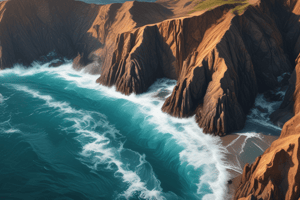Podcast
Questions and Answers
What is the primary characteristic of oceanic ridges?
What is the primary characteristic of oceanic ridges?
- They are mostly submerged under land.
- They are typically located on continental plates.
- They generate new ocean floor. (correct)
- They exist only in polar regions.
How long is the global oceanic ridge system?
How long is the global oceanic ridge system?
- Around 100,000 kilometers
- Approximately 70,000 kilometers (correct)
- Over 50,000 kilometers
- Typically 30,000 kilometers
What geological process primarily occurs at divergent plate boundaries?
What geological process primarily occurs at divergent plate boundaries?
- Formation of mountains
- Seafloor spreading (correct)
- Converging tectonic plates
- Subduction of plates
What feature is commonly found along the crest of some segments of oceanic ridges?
What feature is commonly found along the crest of some segments of oceanic ridges?
What average rate does seafloor spreading occur?
What average rate does seafloor spreading occur?
Which of these regions features slow seafloor spreading of about 2 centimeters per year?
Which of these regions features slow seafloor spreading of about 2 centimeters per year?
Which statement about oceanic ridges is false?
Which statement about oceanic ridges is false?
What main force is associated with the formation of rift valleys along oceanic ridges?
What main force is associated with the formation of rift valleys along oceanic ridges?
What is the primary process responsible for generating new oceanic crust?
What is the primary process responsible for generating new oceanic crust?
What feature primarily characterizes divergent plate boundaries?
What feature primarily characterizes divergent plate boundaries?
As oceanic lithosphere ages, what happens to its thickness?
As oceanic lithosphere ages, what happens to its thickness?
What is a consequence of the cooling of the upper asthenosphere as it moves away from the zone of upwelling?
What is a consequence of the cooling of the upper asthenosphere as it moves away from the zone of upwelling?
How long does it take for the temperature of oceanic lithosphere to stabilize?
How long does it take for the temperature of oceanic lithosphere to stabilize?
What causes the ocean depth to increase away from the ridge crest?
What causes the ocean depth to increase away from the ridge crest?
How is the newly formed oceanic crust affected by contact with cold ocean water?
How is the newly formed oceanic crust affected by contact with cold ocean water?
What is the approximate maximum thickness of oceanic lithosphere?
What is the approximate maximum thickness of oceanic lithosphere?
Flashcards are hidden until you start studying
Study Notes
Divergent Plate Boundaries
- Most divergent plate boundaries are found at oceanic ridges, functioning as constructive plate margins generating new ocean floor.
- Oceanic ridges are characterized by high heat flow, volcanism, and form the longest topographic feature on Earth, over 70,000 kilometers (43,000 miles) long.
- Major segments of the global ridge system include the Mid-Atlantic Ridge, East Pacific Rise, and Mid-Indian Ridge, covering 20% of Earth’s surface.
- The average elevation of oceanic ridges is 2 to 3 kilometers (1 to 2 miles) above adjacent ocean basins, despite varying widths from 1,000 kilometers (600 miles) to over 4,000 kilometers (2,500 miles).
- Ridges often feature rift valleys, evidence of tensional forces pulling apart the ocean crust.
Seafloor Spreading
- Seafloor spreading is the process generating new oceanic crust at divergent boundaries, averaging about 5 centimeters (2 inches) per year.
- Slow spreading rates of approximately 2 centimeters (1 inch) per year occur at the Mid-Atlantic Ridge, while faster rates over 15 centimeters (6 inches) have been observed at the East Pacific Rise.
- All of Earth’s oceanic lithosphere has been produced in the last 200 million years through this process.
- The mechanism involves the movement of two adjacent plates away from each other, creating fractures in the ocean crust that allow magma from the mantle to rise and solidify.
Aging of Oceanic Lithosphere
- The lithospheric mantle under newly formed crust is thin due to the high temperatures of the upwelling mantle.
- Newly formed oceanic crust cools quickly in contact with ocean water, maintaining a thickness of about 7 kilometers (4 miles).
- As the oceanic crust moves away from the hot upwelling zone, it cools, thickens, and becomes denser over time, stabilizing around 80 million years after formation.
- The maximum thickness of the oceanic lithosphere can reach about 100 kilometers (60 miles) as it ages.
- The increase in lithospheric density and thickness contributes to the greater ocean depth observed away from the ridge crest.
Studying That Suits You
Use AI to generate personalized quizzes and flashcards to suit your learning preferences.




